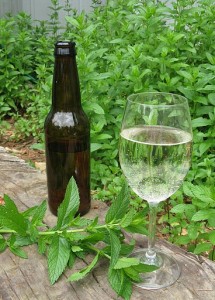Use Your Bounty to Make Garden Wines
Posted in Exhibitions, The Edible Garden on October 14 2010, by Plant Talk
 |
Nan K. Chase is the author of Eat Your Yard! She will be at the Garden for a booksigning on October 16 at 3 p.m. during the final weekend of The Edible Garden. |
 I’m three years into a new garden, a tiny bungalow yard near downtown Asheville, N.C., that I have crammed full of dwarf fruit trees, berry bushes, fruiting vines, roses (for edible petals and nutritious “hips”), yuccas and sunflowers, short and tall herbs, and even a few vegetables.
I’m three years into a new garden, a tiny bungalow yard near downtown Asheville, N.C., that I have crammed full of dwarf fruit trees, berry bushes, fruiting vines, roses (for edible petals and nutritious “hips”), yuccas and sunflowers, short and tall herbs, and even a few vegetables.
It’s shocking how much produce the family has had this year despite searing temperatures and a shortfall of rain. Now that I have written a garden book about edible landscape design and how to preserve the harvest, readers I meet are pushing me to try more, learn more, and share more information. So now I’m moving into wines.
Garden wines are nothing new. People in ancient times made wine or the honey-rich fermentation called mead out of everything they grew: grapes, of course, but also pears, peaches, quince, plums, crab apples, berries, numerous herbs and flowers, vegetables and root crops, tender new leaves, and even grains and onions.
The first garden wine I made was mint wine, and it turned out so well that I was scared to make wine again for a few years (the mint wine was crystal clear, slightly fizzy at first, and tasted as light as pinot grigio). I’m over the beginner’s luck jitters and have made a delightful fruit-based rice wine (sake) and a dandelion wine, which awaits bottling. Next, thanks to a huge crab apple harvest, comes crab apple wine; the recipe starts with just five pounds of fruit.
Herb wines are especially good for city dwellers, since herbs can grow prolifically in small spaces, even in pots on a balcony.
Fermentation is magical and simple: sugar plus yeast equals alcohol, at least if everything bubbles along in a dark place at a moderate temperature. Fruit is naturally rich in sugar and ferments easily; but it’s also possible to make wine from a sugar (or honey) solution infused with delicate flavors from flowers, herbs, or other low-sugar produce.
My mint wine recipe is the easiest to explain. Equipment includes a clean glass vessel with a small mouth to hold the fermenting ingredients, a big bowl for rinsing and cleaning mint leaves, a kettle for dissolving sugar in boiling water, a packet of bread yeast, and a small plastic bag to loosely seal in the fermentation mash. Later, you’ll need bottles, perhaps a fine sieve, and a funnel.
Starting with a five-gallon vessel—the maximum needed—the proportions are 7 pounds of sugar dissolved in 3 gallons of water and cooled to lukewarm, and 3 quarts of clean mint leaves. Mix the leaves and cooled water in the vessel, activate the yeast just like for bread dough, and drop it in. Then cover and let the mixture sit for a month or two. It goes from gunky to clear when it has finished fermenting. The recipe appears in my book Eat Your Yard!
If mint wine sounds too exotic for words, it’s not. As with any recipe, it just takes one delicious success to get hooked.


Hi
Love the recipe for mint wine. Sounds like fun.
Do you leave this mixture of mint and sugar water at room temperature on a kitchen counter?
Thanks
Neela